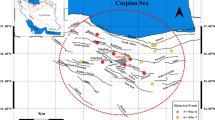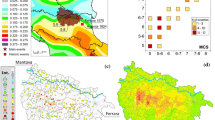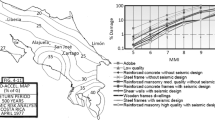Abstract
The second part of a seismic risk assessment study for the Iranian city of Isfahan is presented, focusing on the description of the hazard, the risk analysis, and the discussion of the results. This study utilizes the building exposure model, the fragility and the vulnerability curves illustrated in the companion paper. The earthquake occurrence source model adopted is based on the EMME14 hazard study. The site effects accounting for the soil nonlinear behavior are modeled by means of a Vs30 map derived from the topographical slope. The validity of this map is tested based on the local surface geology and geotechnical reports. The probabilistic seismic hazard maps for different return periods that account for site effects are generated and compared with the design spectra mandated by the Iranian national seismic design code. In addition, direct seismic monetary and human losses are estimated for two earthquake scenarios and also for 100- and 475-year return periods. We show loss maps and loss curves, offering insights on the most vulnerable building classes and the spatial distribution of the estimated losses. The results provide a basis for pre- and post-disaster emergency planning, for global and local urban planning, as well as for conceiving adequate risk mitigation strategies including devising fair earthquake insurance policies. This study may also serve as a blueprint for carrying out similar work in other urban areas of the Middle East.












Similar content being viewed by others
References
Abdi F, Mirzaei N, Shabani E (2013) Ground-motion scenarios consistent with PSH deaggregation for Tehran, capital city of Iran. Nat Hazards Earth Syst Sci 13:679–688. https://doi.org/10.5194/nhess-13-679-2013
Abdolahi M, Jafarian M, Goodarzi G, Pirhadi G, Partoazar H (2014) Geology map reports for Isfahan-Felavarjan. Geological Survey & Mineral Explorations of Iran (GSI), Zamin danesh Pars Engineering consultants, Tehran
Abrahamson N, Silva W (2008) Summary of the Abrahamson & Silva NGA ground-motion relations. Earthq Spectra 24:67–97. https://doi.org/10.1193/1.2924360
Abrahamson NA, Silva WJ, Kamai R (2014) Summary of the ASK14 ground motion relation for active crustal regions. Earthq Spectra 30:1025–1055. https://doi.org/10.1193/070913eqs198m
Akkar S, Cagnan Z (2010) A local ground-motion predictive model for Turkey, and its comparison with other regional and global ground-motion models. Bull Seismol Soc Am 100:2978–2995. https://doi.org/10.1785/0120090367
Akkar S, Sandıkkaya MA, Bommer JJ (2014) Empirical ground-motion models for point- and extended-source crustal earthquake scenarios in Europe and the Middle East. Bull Earthq Eng 12:359–387. https://doi.org/10.1007/s10518-013-9461-4
Alavi E, Mahootchian A, Yadegari S, Shamsodin M, Babania Nouri M, Ordoubadi B (2018) Report of M7.3 Ezgele, Kermanshah, Iran Earthquake on November 12, 2017, EERI reports
Ambraseys NN, Melville CP (1982) A history of Persian earthquakes. Cambridge University Press, Cambridge. https://doi.org/10.1002/eqe.4290110412
ATC20 (1989) Procedures for post earthquake safety evaluation of buildings
Baker J, Jayaram N (2008) Correlation of spectral acceleration values from NGA ground motion models. Earthq Spectra 24:299–317
Bazzurro P, Cornell CA (2004) Nonlinear soil-site effects in probabilistic seismic-hazard analysis. Bull Seismol Soc Am 94:2110–2123
Bazzurro P, Luco N (2005) Accounting for uncertainty and correlation in earthquake loss estimation. In: Proceedings of the ninth international conference on structural safety and reliability, Rome, Italy, pp 2687–2694
Bazzurro P, Luco N (2007) Effects of different sources of uncertainty and correlation on earthquake-generated losses. Aust J Civ Eng. https://doi.org/10.1080/14488353.2007.11463924
Benjamin JR, Cornell CA (1970) Probability, statistics, and decision for civil engineers. McGraw-Hill, New York
Beygi S, Nadimi A, Safaei H (2016) Tectonic history of seismogenic fault structures in Central Iran. J Geosci 61:127–144
Boore DM, Stewart JP, Seyhan E, Atkinson GM (2014) NGA-West2 equations for predicting PGA, PGV, and 5% damped PSA for shallow crustal earthquakes. Earthq Spectra 30:1057–1085. https://doi.org/10.1193/070113eqs184m
Campbell KW, Bozorgnia Y (2014) NGA-West2 ground motion model for the average horizontal components of PGA, PGV, and 5% damped linear acceleration response spectra. Earthq Spectra 30:1087–1115. https://doi.org/10.1193/062913eqs175m
Cauzzi C, Faccioli E, Vanini M, Bianchini A (2015) Updated predictive equations for broadband (0.01–10 s) horizontal response spectra and peak ground motions, based on a global dataset of digital acceleration records. Bull Earthq Eng 13:1587–1612. https://doi.org/10.1007/s10518-014-9685-y
Chiou B-J, Youngs RR (2008) An NGA model for the average horizontal component of peak ground motion and response spectra. Earthq Spectra 24:173–215. https://doi.org/10.1193/1.2894832
Chiou BS-J, Youngs RR (2014) Update of the Chiou and Youngs NGA model for the average horizontal component of peak ground motion and response spectra. Earthq Spectra 30:1117–1153. https://doi.org/10.1193/072813eqs219m
Crowley H, Bommer JJ, Pinho R, Bird J (2005) The impact of epistemic uncertainty on an earthquake loss model. Earthq Eng Struct Dyn 34:1653–1685. https://doi.org/10.1002/eqe.498
Danciu L, Kale Ö, Akkar S (2016a) The 2014 earthquake model of the Middle East: ground motion model and uncertainties. Bull Earthq Eng. https://doi.org/10.1007/s10518-016-9989-1
Danciu L, Sesetyan K, Demircioglu M, Erdik M, Giardini D (2016b) OpenQuake input files of the seismogenic source model of the 2014 earthquake model of the Middle East (EMME-Project). https://doi.org/10.12686/a3
Danciu L et al (2017) The 2014 earthquake model of the Middle East: seismogenic sources. Bull Earthq Eng. https://doi.org/10.1007/s10518-017-0096-8
Douglas J, Edwards B (2016) Recent and future developments in earthquake ground motion estimation. Earth Sci Rev 160:203–219. https://doi.org/10.1016/j.earscirev.2016.07.005
Erdik M, Şeşetyan K, Demircioğlu MB, Hancılar U, Zülfikar C (2011) Rapid earthquake loss assessment after damaging earthquakes. Soil Dyn Earthq Eng 31:247–266. https://doi.org/10.1016/j.soildyn.2010.03.009
Erdik M, Sesetyan K, Demircioğlu M, Tüzün C (2012) Assessment of seismic hazard in the Middle East and Caucasus: EMME (Earthquake Model of Middle East) Project. Paper presented at the 15WCEE, 24–28 September, Lisbon, Portugal
Fallah Tafti M, Amini Hosseini K, Firouzi E, Mansouri B, Ansari A (2017) Ranking of GMPEs for seismic hazard analysis in Iran using LH, LLH and EDR approaches. J Seismol Earthq Eng 19:139–161
FEMA-P58 (2012) Federal Emergency Management Agency: Seismic Performance Assessment of Buildings, prepared by the Applied Technology Council for the Federal Emergency Management Agency, Washington, DC
Firuzi E, Ansari A, Amini Hosseini K, Rashidabadi M (2019) Probabilistic earthquake loss model for residential buildings in Tehran, Iran to quantify annualized earthquake loss. Bull Earthq Eng 17:2383–2406. https://doi.org/10.1007/s10518-019-00561-z
Ghasemi H, Zare M, Fukushima Y, Koketsu K (2009) An empirical spectral ground-motion model for Iran. J Seismol 13:499–515. https://doi.org/10.1007/s10950-008-9143-x
Ghodrati Amiri G, Razeghi HR, Razavian ASA, Aalaee H, Rasouli SM (2008) Seismic hazard assessment of Shiraz, Iran. J Appl Sci 8:38–48
Giardini D (1999) The Global Seismic Hazard Assessment Program (GSHAP)—1992/1999 1999 42. https://doi.org/10.4401/ag-3780
Goda K (2015) Seismic risk management of insurance portfolio using catastrophe bonds. Comput Aid Civ Infrastruct Eng 30:570–582. https://doi.org/10.1111/mice.12093
Goda K, Hong HP (2008) Estimation of seismic loss for spatially distributed buildings. Earthq Spectra 24:889–910. https://doi.org/10.1193/1.2983654
Goda K, Yoshikawa H (2012) Earthquake insurance portfolio analysis of wood-frame houses in south-western British Columbia, Canada. Bull Earthq Eng 10:615–643. https://doi.org/10.1007/s10518-011-9296-9
Goda K, Wenzel F, Daniell J (2014) Insurance and reinsurance models for earthquake. In: Beer M, Kougioumtzoglou IA, Patelli E, Au IS-K (eds) Encyclopedia of earthquake engineering. Springer, Berlin. https://doi.org/10.1007/978-3-642-36197-5_261-1
ICSRDB (2014) Iranian code of practice for earthquake resistant design of buildings (Standard 2800), 4th edn. PN S 253, Building and Housing Research Center of Iran, Tehran
Jafari MK et al (2005) Seismic hazard study, final report for Tehran Comprehensive Plan. International Institute of Earthquake Engineering and Seismology (IIEES), Iran
Jaiswal K, Wald D (2013) Estimating economic losses from earthquakes using an empirical approach. Earthq Spectra 29:309–324. https://doi.org/10.1193/1.4000104
JICA (2000) The study on seismic microzoning of the greater Tehran area in the Islamic Republic of Iran, final report
Jonkman SN, van Gelder PHAJM, Vrijling JK (2003) An overview of quantitative risk measures for loss of life and economic damage. J Hazard Mater 99:1–30. https://doi.org/10.1016/S0304-3894(02)00283-2
Kale Ö, Akkar S, Ansari A, Hamzehloo H (2015) A ground-motion predictive model for Iran and Turkey for horizontal PGA, PGV, and 5% damped response spectrum: investigation of possible regional effects. Bull Seismol Soc Am 105:963–980. https://doi.org/10.1785/0120140134
Kamalian M, Jafari MK, Ghayamghamian MR, Shafiee A, Hamzehloo H, Haghshenas E, Sohrabi-bidar A (2008) Site effect microzonation of Qom, Iran. Eng Geol 97:63–79. https://doi.org/10.1016/j.enggeo.2007.12.006
Kohrangi M, Danciu L, Bazzurro P (2018) Comparison between outcomes of the 2014 Earthquake Hazard Model of the Middle East (EMME14) and national seismic design codes: the case of Iran. Soil Dyn Earthq Eng 114:348–361. https://doi.org/10.1016/j.soildyn.2018.07.022
Kohrangi M, Bazzurro P, Vamvatsikos D (2021) Seismic risk and loss estimation for building stock in Isfahan. Part I: exposure and vulnerability. Bulletin of Earthquake Engineering (under review)
Mansouri B, Ghafory-Ashtiany M, Amini-Hosseini K, Nourjou R, Mousavi M (2010) Building seismic loss model for Tehran. Earthq Spectra 26:153–168. https://doi.org/10.1193/1.3280377
Mansouri B, Kiani A, Amini-Hosseini K (2014) A platform for earthquake risk assessment in Iran case studies: Tehran scenarios and Ahar-Varzeghan earthquake. J Seismol Earthq Eng 16:51–69
Moinfar AA, Naderzadeh A, Nabavi MH (2012) New Iranian seismic hazard zoning map for new edition of seismic code and its comparison with neighbor countries. Paper presented at the 15th WCEE, Lisbon, Portugal
Motamed H, Calderon A, Silva V, Costa C (2019) Development of a probabilistic earthquake loss model for Iran. Bull Earthq Eng 17:1795–1823. https://doi.org/10.1007/s10518-018-0515-5
Park J, Bazzurro P, Baker JW (2007) Modeling spatial correlation of ground motion intensity measures for regional seismic hazard and portfolio loss estimation. Paper presented at the applications of statistics and probability in civil engineering—Kanda, Takada & Furuta (eds)
Sadeghi M, Hochrainer-Stigler S, Ghafory-Ashtiany M, Pakdel-Lahiji N (2014) Earthquake risk modeling for the evaluation of losses to property owners in the metropolitan area of Shiraz. In: Proceedings of the 10th U.S. national conference in earthquake engineering. Earthquake Engineering Research Institute, Anchorage, AK
Sadeghi M, Hochrainer-Stigler S, Ghafory-Ashtiany M (2015) Evaluation of earthquake mitigation measures to reduce economic and human losses: a case study to residential property owners in the metropolitan area of Shiraz, Iran. Nat Hazards 78:1811–1826. https://doi.org/10.1007/s11069-015-1801-z
Safaei H (2005) Identify and evaluate the seismic potential of faults around Isfahan. Final report of the research project, University of Isfahan (in Farsi)
Safaei H, Tabatabaeimanesh SM, Hashemi SN, Mirlohi AS, Vafa H (2012) Structural and petrological evidence for the continuation of the Isfahan fault system across the Urumieh-Dokhtar zone of central Iran. Geotectonics 46:455–471. https://doi.org/10.1134/s0016852112060064
Sandıkkaya MA, Akkar S, Bard P-Y (2018) A probabilistic procedure to describe site amplification factors for seismic design codes. Soil Dyn Earthq Eng. https://doi.org/10.1016/j.soildyn.2018.01.050
Şeşetyan K et al (2018) The 2014 seismic hazard model of the Middle East: overview and results. Bull Earthq Eng. https://doi.org/10.1007/s10518-018-0346-4
Shafiee A, Kamalian M, Jafari MK, Hamzehloo H (2011) Ground motion studies for microzonation in Iran. Nat Hazards 59:481–505. https://doi.org/10.1007/s11069-011-9772-1
Silva V (2019) Uncertainty and correlation in seismic vulnerability functions of building classes. Earthq Spectra 35:1515–1539. https://doi.org/10.1193/013018EQS031M
Silva V, Crowley H, Pagani M, Monelli D, Pinho R (2014) Development of the OpenQuake engine, the Global Earthquake Model’s open-source software for seismic risk assessment. Nat Hazards 72:1409–1427. https://doi.org/10.1007/s11069-013-0618-x
Tajmir Riahi Z, Ajalloeian R, Rahgozar MA, Safaei H (2014) Earthquake hazard zonation of the Isfahan City, Iran. J Geotech Eng 19:7141–7163
Vernant P et al (2004) Deciphering oblique shortening of central Alborz in Iran using geodetic data. Earth Planet Sci Lett 223:177–185. https://doi.org/10.1016/j.epsl.2004.04.017
Wair B, DeJong JT, Shantz T (2012) Guidelines for estimation of shear wave velocity profiles. PEER 2012/08
Wald DJ, Allen TI (2007) Topographic slope as a proxy for seismic site conditions and amplification. Bull Seismol Soc Am 97:1379–1395. https://doi.org/10.1785/0120060267
Weatherill GA, Silva V, Crowley H, Bazzurro P (2015) Exploring the impact of spatial correlations and uncertainties for portfolio analysis in probabilistic seismic loss estimation. Bull Earthq Eng 13:957–981. https://doi.org/10.1007/s10518-015-9730-5
Whitehead J, Rose A (2009) Estimating environmental benefits of natural hazard mitigation with data transfer: results from a benefit-cost analysis of Federal Emergency Management Agency hazard mitigation grants. Mitig Adapt Strat Glob Change 14:655–676. https://doi.org/10.1007/s11027-009-9189-2
Yazdi-Samadi MR, Mahsuli M (2018) Time-variant seismic risk analysis of transportation networks considering economic and socioeconomic impacts. J Earthq Eng. https://doi.org/10.1080/13632469.2018.1453401
Zafarani H, Mousavi M (2014) Applicability of different ground-motion prediction models for northern Iran. Nat Hazards 73:1199–1228. https://doi.org/10.1007/s11069-014-1151-2
Zafarani H, Hajimohammadi B, Jalalalhosseini SM (2017) Earthquake hazard in the Tehran region based on the characteristic earthquake model. J Earthq Eng. https://doi.org/10.1080/13632469.2017.1387189
Zare M (2010) Fundamental of seismic hazard analyses. Intern Inst Earthq Eng Seism (IIEES), in Persian, Tehran, Iran
Zare M (2015) Probabilistic seismic hazard zoning in Iran: a state of the art on the studies during four decades. Paper presented at the 7th international conference on seismology & earthquake engineering, Tehran, 18–21 May
Zare M et al (2014) Recent developments of the Middle East catalog. J Seismol 18:749–772. https://doi.org/10.1007/s10950-014-9444-1
Zhao JX et al (2006) Attenuation relations of strong ground motion in Japan using site classification based on predominant period. Bull Seismol Soc Am 96:898–913. https://doi.org/10.1785/0120050122
Zhao J, Lee JY, Li Y, Yin Y-J (2019) Effect of catastrophe insurance on disaster-impacted community: Quantitative framework and case studies. Int J Disaster Risk Reduct 43:101387. https://doi.org/10.1016/j.ijdrr.2019.101387
Zolfaghari MR (2010) Application of catastrophe loss modelling to promote property insurance in developing countries. Disasters 34:524–541. https://doi.org/10.1111/j.1467-7717.2009.01141.x
Acknowledgements
The authors wish to acknowledge the technical support of Dr. Laurentiu Danciu in the selection of GMPEs and the application of the EMME source model. We would also like to thank Dr. Bahram Nadi for his suggestions on the spatial distribution of different soil types in Isfahan. We thank Dr. Fabrizio Pelli for useful discussions in interpreting the geotechnical experimental test results. We are grateful to Mauro Mangini, Dr. Ettore Fagà and Anna Mottadelli of RED for their help with GIS technical suggestions and providing the computational resources to perform the hazard and risk analyses of this study. We are also grateful for the technical comments about OpenQuake modeling provided by Dr. Vitor Silva and Dr. Michele Simionato at GEM foundation. We thank the Isfahan Urban Railway Organization for providing us with the geotechnical reports for Isfahan. Finally, we thank the associate editor and three anonymous reviewers whose comments and suggestions significantly increased the quality and the clarity of this manuscript.
Funding
The first author is grateful for the financial support provided by the Iranian National Elites Foundation and by the Scuola Universitaria Superiore IUSS Pavia. Additional financial support has been provided by the Executive Agency for Small and Medium-sized Enterprises (EASME) under the powers delegated by the European Commission through the Horizon 2020 program “HYPERION- Development of a decision support system for improved resilience & sustainable reconstruction of historic areas to cope with climate change & extreme events based on novel sensors and modelling tools”, Grant Agreement Number 821054.
Author information
Authors and Affiliations
Corresponding author
Ethics declarations
Conflict of interest
The authors declare that they have no conflict of interest.
Additional information
Publisher's Note
Springer Nature remains neutral with regard to jurisdictional claims in published maps and institutional affiliations.
Mohsen Kohrangi: Formerly at: Scuola Universitaria Superiore IUSS Pavia, Pavia, Italy.
Rights and permissions
About this article
Cite this article
Kohrangi, M., Bazzurro, P. & Vamvatsikos, D. Seismic risk and loss estimation for the building stock in Isfahan: part II—hazard analysis and risk assessment. Bull Earthquake Eng 19, 1739–1763 (2021). https://doi.org/10.1007/s10518-020-01037-1
Received:
Accepted:
Published:
Issue Date:
DOI: https://doi.org/10.1007/s10518-020-01037-1




